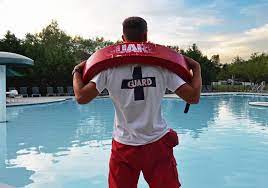23 December 2022: Lifeguards are a crucial component of water safety, especially during the festive season. However, it is essential to understand that lifeguards are not just a few fit youngsters sitting on a beach waiting for someone to get into trouble and then simply go rescue them.
This is according to Brett Ayres, Executive Director of Rescue Services at the National Sea Rescue Institute (NSRI) who further states that there is a lot more that goes into running a lifeguarding service than one thinks.
“Lifeguarding is a system. It boils down to effective training and development of lifeguards, great equipment and quality management. Our NSRI Lifeguarding unit has already conducted 29 rescues, 40 first aid treatments and 2433 prevention interventions since the 1st December 2022. Prevention is the real job of a good lifeguard, stopping an incident before it becomes a rescue, or a tragedy.”
“The NSRI’s lifeguard units are equipped with fins, wetsuits, malibu boards and torpedo buoys to help them get out on the water and effectively perform a rescue quickly but once the casualty is out of the water, they also have the appropriate first aid equipment, oxygen and an AED (automated external defibrillator) required to save lives. Our lifeguards are backed up by a VHF radio and cellphone network and are supported by our Sea Rescue base stations, beach safety cameras and national Emergency Operations Centre that can activate a network of higher care in any emergency.
Currently providing services to 5 municipalities and 26 beaches, the NSRI uses an app, developed in 2019, to report on this real-time data from our lifeguarded beaches, and this also reports on the beach conditions and beachgoer attendance. In addition to this, the app allows lifeguards to perform daily equipment checks and send alerts out when equipment or disposable stock is low – all part of the effective management system.” Ayres adds.
“So far, we have seen over 43 800 bathers on our lifeguarded beaches, of which over 13 300 entered the water, and no major incidents have been reported – so holding thumbs that the trend continues. I would encourage any member of the public to ask their local municipality what equipment, training and support systems their lifeguards have in place to ensure beaches are safe this summer and to only swim at lifeguarded beaches” concludes Brett.
For further insights into why the NSRI expanded into lifeguarding, some of the challenges we face and more of the innovative solutions.


![TOP STORY | MAKHADZI 'MUST PAY BACK THE MONEY'- MANAGER PHILANI BY THANDI MATHEBULA Acclaimed Xitsonga Music Promoter, popularly known as Manager Philani, took to Facebook and accused BET Award winner Makhadzi. According to Philani, Makhadzi was paid R55k to perform in 2022, but Makhadzi never showed up and never paid back the money. On Wednesday, morning, 10 July 2024, Makhadzi displayed emotional response on social media after the Department of Sport, Arts and Culture revealed that she had received R230, 000 from the Department in the last 14 months, but Philani did not show any sympathy. Philani wrote that: [Swa Venda Artist liya swi tshikeleni Mina but what I know is she is taking advantage of us Tsonga People and hide with the word TRIBALISM...] Loosely translated- leave the Venda queen to me, but one thing for sure I know is that she is taking advantage of us Tsonga people and hiding behind the term 'tribalism'. BELOW IS PHILANI'S DETAILED ACCOUNT OF WHAT TRANSPIRED: We were the first to book her for Spring weekend from the start of negotiations and paid her the deposit on the spot after our first meeting at her Fourways house. The balance was paid to her 10 days before the event. We realized there was a problem when she started not communicating and not returning or answering our calls prior to the event. It turned out that our event clashed with her event in Botswana, and she ditched us without any communication. At approximately 19:00 on the day of the event (03/09/2022), she called to inform us that she was from another event in Midrand and would perform at 20:00 before departing. She didn't arrive as promised and left many of her Tsonga fans disappointed. Our next effort was to meet her at one of her events, where it was agreed that we forgive and forget, and that she would come to our next event to pay back the money. Even after giving her a second chance, it was still a struggle as her manager (Maphuthi) asked for a ridiculous amount on top of the R55k that was agreed and paid in full. Our lawyers finally sent a letter of demand for the payment after numerous attempts. She then started asking for an invoice so she could pay back the money (R55k) An invoice was sent to her, but payment has not been received to date. Your Queen must Pay Back the Money Period!!! In the past week, Makhadzi has opened up about her financial struggles. According to Makhadzi, she has to pay SARS every month when she receives money, resulting in her not having any money for herself.](http://limpoponewsupdate.co.za/wp-content/uploads/2024/07/Makhadzi-400x245.jpeg)



